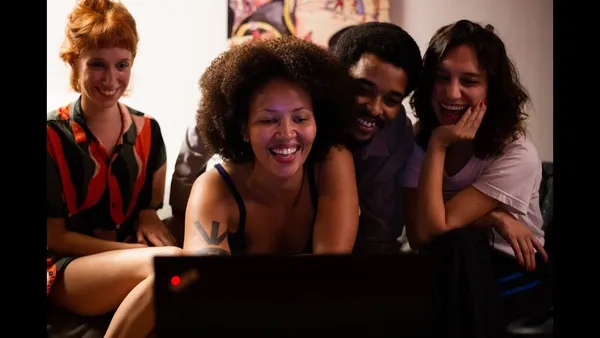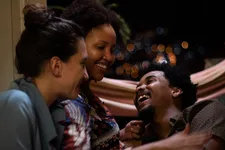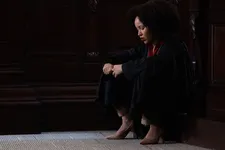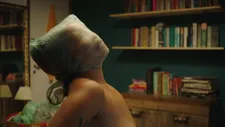 |
| Rule 34 Photo: courtesy of Newfest |
When I connect with her, Brazilian director Júlia Murat has recently arrived in New York City for this year’s Newfest, where her film Rule 34 (Regla 34) is to screen. It’s the story of Simone (played by Sol Miranda), a young woman who works as a cam girl in order to support herself through law school. When a girlfriend and fellow sex worker tries to persuade her to experiment with pain and bondage, Simone is initially reluctant, not least because of the semiotics of putting herself in that position as a black woman, but as she begins to test boundaries in both her private and professional lives, she embarks on a journey which changes her perspective on the world and the way she interacts with other people.
The idea, Júlia tells me, was to develop a character who is distanced from the world and is in some ways extremely private, but who gives the appearance of having easy-going, close relationships with others. Simone is a character who has had a difficult life, facing various forms of oppression and yet still managing to make her way in a society which demands a lot of her.
“Somehow she created a barrier,” Júlia explains. “She created like a wall in between her and the universe that allowed her to protect herself. And it's exactly this wall that she's trying to deal with now. I think so. So although it was not because of that, that I created this universe, I think that those characteristics would define what I was looking for to create Simone’s character.”
So what was the reason that she created this universe? What was the most important part of the story that she wanted to tell?
To explain that, she says, she will need to go back a bit to talk about the history of the project, which began with her desire to make a film about sexuality.
 |
| Rule 34 Photo: courtesy of Newfest |
“I didn't know exactly what I was looking for. So I started studying pornography. And I started studying it because although I'm not a moralistic a person, I had always had a prejudice about pornography. I have never had any desire for it. So there was something behind the idea of the universe of pornography that I was interested. So I started from this process, studying pornography a lot, and I did an interview with Sasha Grey. She's an American actress. In that interview, she was saying that pornography is about expanding your limits, both social, emotional and your body. So, when I listened to this interview, I realised that that was something that not only I related to my life, in my desires, but also something that I could understand. I could attach.
“So from that interview, Simone appeared. Simone is someone who is trying to extend her limits – any kind of limits. I decided to do a film about someone trying to extend her limits, and to do so I decided to bring in desire of violence. But I thought that I was doing it because the desire of violence was something that I had also a huge prejudice. My mom was in jail during the dictatorship in Brazil. She was very much tortured, so I was raised with this idea of torture being something that was very strong in my mind. So the idea of having desire of violence was something that I couldn't completely understand.
“Since I want Simone to push her limits, I decided that I should actually choose one subject that I will have to push my own limits. So that's why violence came into the list. So now I have a film about someone who was willing to push the limits for the desire of violence, but in Brazil, and then I started realising that it spoke about the desire of violence in a society, as patriarchal – well, of course, all societies are patriarchal, but in Brazil, it's even worse. So when I started realising that, I also understood that I couldn't, or shouldn't, or I didn't want to talk about desire of violence without contextualising it.
“Then the idea of the public defence came, because if we are talking about oppression, violence, the demands of society on an individual, all those subjects are completely defined by a penal system. So the penal system came to actually try to contextualise the whole process of violence and oppression.”
In the film, we see Simone helping out with domestic abuse cases. Some of these involve violence but in one case concerns are initially raised about controlling behaviour. Did Júlia feel that it was important to highlight the different forms which violence can take?
“Yes,” she says, “for many reasons, but one of those is that [in 2006] we had a change in the law. We started having this law that is called Maria da Penha law, for domestic violence. And in that law, it defines, I think, five different kinds of violence. One is the physical violence, but all others are like, controlling violence, financial violence, all those kinds of violence, abusive violence that is not about the physical body. There is a discussion inside the film about the failure to use the penal system in order to to help the freedom of women. So, the way men have chosen, in Brazil, to try to be against oppression, is actually using another oppressive system.
 |
| Rule 34 Photo: courtesy of Newfest |
“For me, to bring in Maria da Penha in all its levels was important not only to talk about these different kinds of violence that exist in the world, but also to talk about this system that we as anti-oppression people are using, just like using the oppression to create another oppression.”
We talk about how the film addresses questions around autonomy and the ability of people who face structural disadvantages to make their own free choices. There’s a lot there about women, and also about race. Júlia says that initially, in the writing stages, Simone was not necessarily going to be black.
“She was someone who came from a low class and was now changing her social category. And, therefore, she could be black or white in the sense that the majority of the people in Brazil who are from the lower classes are black, so it would be it made sense, but I also was very much afraid of creating the character of a black woman desiring violence. Specifically because of what she says in the beginning of the film, but not only tyhat – it's also because I am a white Brazilian, which brings in more complicated things. Also because it's not only about herself as a character, but it was also what kind of image we want to create, in order to not paint this idea of violence on black bodies.”
She was persuaded to take on the challenge by director’s assistant Gabriel Bortolini, who is black, she explains.
“We discussed a lot about it. And he was always saying, ‘Okay, of course, we have a problem. I’m not being naïve. But if you do it wrong, it would be bad no matter if she’s white or she’s black. What we need to do is not get it wrong.’” She laughs. “Of course, it puts more pressure on us because it's even worse. But he was saying, ‘What we need to do is not get it wrong.’ So at the same time, we realised that most of the people who were against the idea of her being black were white people. Because we are all afraid. And the black people said ‘You guys are crazy, but let's do it. If you do it correctly, it will generate something quite important.’
“It was also because the black movies in Brazil – and everywhere, but in Brazil, specifically – so many times remove the possibility of talking about different things besides oppression. I saw many interviews, texts, meetings, with black people saying ‘I just want to talk about sex. I just want to talk about relationships, about friends, and I don't want to be talking about the whole time about oh my God it’s oppressive.’ So bringing it all together, we decided to present her as a black woman.”
Finding the right actress must have influenced that decision too.
“For sure,” she says. “We were looking at actors who were black and white. Sol had exactly what I was looking for, in the sense that she is this person, very intense, with a huge generosity, but at the same time, completely opaque. There is something in her that is quite difficult to search. That is something that is interesting, because usually in an actors’ test, the actors and actresses really try to show themselves, and Sol wasn't because she has this protection that didn’t allow me to completely search. So it was very interesting to see her.”
 |
| Rule 34 Photo: courtesy of Newfest |
The acting itself, in the audition, was not the strongest, she says, but she had a strong feeling about Sol’s potential and knew that it would be worth taking the time to invest in her and help her connect with the role.
“I knew it would be tough. We needed to work a lot. But she had the potential to go for it, and she's – well, she’s generous, but she's also someone who wills a lot, someone who desires a lot. She had it all. So I had no doubt about her capacity at all. There was a month and a half of rehearsing and also we did many different kinds of class. We did tantra. She went to the law school.”
The moment which really stands out iin her performance is the last scene, when the camera lingers on her face, and Júlia says that it was always important to her to find someone whose face could move back and forth between two emotional states in that scene, because she didn’t want to give the film too simple an ending.
With numerous sex scenes in the film, there are obvious issues around keeping the actors safe and comfortable. Júlia had a very practical way of going about that.
“From the beginning, we had the idea that the set would be a place to protect actors. So what we created was two different sets. On the first set, were all house and sex scenes. Not only the sex scenes, all the scenes that happens in the house, the scenes with her friends, the scenes in the kitchen, the scenes where she is studying – all those kind of scenes. And in the second part of the set would be the law classes, bars, parties, those kinds of scenes. So we create these two groups of things, and for the first one, the idea was to have only a very, very small group.
“In Pendular, my second film, there were also some sex scenes, and during the film I realised that the moment we did the sex scenes, what happened was, they left the set so there were only the important people, but I realised that this moment of leaving the set meant that these kind of scenes are different for the other kinds of scenes. And I didn't want to bring that to this film, so that's why we decided to actually create two different groups of scenes. It was four weeks of shooting for this first group. The first group was a very small group. There was basically the photographer, one person for the electric systems, one person for production, Gabriel, and one person for sound – inside the house, with some more people outside. The whole idea was to create a protection for the actors, and then when we arrived to the law school, it was a very different setting.”
The result is a film in which moments of intimacy and nudity feel very natural, and the actors have the space to be immersed in their characters at all times. It’s an impressive piece of work, and one hopes that it will go far beyond the festival circuit.
Rule 34 will enjoy its US première on Saturday 22 October.





















